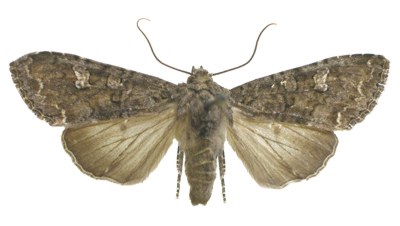Pests
Mamestra brassicae L. - Cabbage Moth.
Systematic position.
Class Insecta, order Lepidoptera, family Noctuidae, subfamily Hadeninae, genus Mamestra.Synonym.
Barathra brassicae L.Biological group.
Polyphagous leaf-chewing pests.Morphology and biology.
Wingspan 40-50 mm. Forewings dark brown with dark cross lines. Reniform spot is surrounded with white, or partly white, border. Sub-marginal line yellow-white with 2 dents, forming the letter "M". Hind wings gray, darker along margins. Female lifespan 2-3 weeks. Average fertility 600 eggs, maximum 2700. Eggs are yellowish white, laid in batches in the shape of an irregular polygon, 20-150 eggs per batch, on the lower side of leaves. Duration of their development is 4-12 days. Caterpillars vary in color from grayish green to dark brown and almost black. Dorsal pattern consists of dark spots shaped like a herring bone; body sides have light stripes in addition to a yellowish one. Caterpillars of 1st instar skeletonize leaves from below, leaving upper epidermis untouched; larvae of 2nd-3rd instars gnaw out apertures. Caterpillars of older instars are nocturnal, hiding at the base of plants in the afternoon. They eat leaves almost completely, leaving only thick veins. Also, they make holes in the plant head, polluting it with excrements, and the head rots. Caterpillars develop over 24-50 days, depending on air and soil temperature and humidity, growing to a body length -- in the last, 6th instar -- of 35-40 mm. Pupae reddish brown. The pupal stage lasts 8-15 days in summer generations. Diapausing pupae winter in ground depth of 5-10 cm.Distribution.
Occurs in North America, Europe, Asia Minor, the Baltics, Byelorussia, Ukraine, Moldova, Transcaucasia, Kazakhstan, and Central Asia. In Russia, it is distributed throughout the European region, Siberia, and the Far East (Primorskii Territory, Sakhalin, Kamchatka, and Southern Kuril islands Kunashir and Iturup).Ecology.
In the north of the distribution area and in mountains, it is monovoltine; in southern regions, it is bi- or trivoltine, causing more harm during the 2nd generation of development. Moths of the 1st generation appear in various forms depending on the zone, usually in May-June; moths of the 2nd generation appear in July-September. The degree days total (or the sum of active temperatures) for development of pupae of summer generation is 230-260°C (at a temperature threshold of 10°C and optimum temperature of 19-21°C); for egg development, 60°C (at a temperature threshold of 10°C and optimum temperature of 16-25°C); for development of caterpillars, 400°C (at a temperature threshold of 9°C and optimum temperature of 16-30°C). This is a hygrophilous species, found more often in areas with high humidity, especially in river flood plains. For oviposition, the moths require additional feeding on flowers. Therefore, the limiting factors of species distribution include low air humidity and the absence of flowering nectariferous plants. Wintering pupae are capable of withstanding long flooding. Entomophages (predators and parasites) and diseases limit pest numbers.Economic significance.
Caterpillars damage cruciferous plants, especially cabbage, leguminous cultures, and sugar beet. In total, they eat plants of more than 70 species of 22 families, including tobacco, sunflower, castor-oil plant, buckwheat, hemp, potato, tomato, rhubarb, corn, and carrots; they also occupy fruiters (apple, pear, and peach trees), ornamental and forest plants. Prefer crucifers and goosefoots. Control measures include autumn plowing, inter-row cultivation of tilled cultures, eradication of weeds, release of Trichogramma in the beginning of moth flight and repeatedly for 7-8 days, and insecticide treatments of plants during the period of caterpillars hatching.Related references:
Klyuchko, Z.F. 1974. Noctuidae. In: Vasil.ev V.P., ed. Pests of agricultural crops and forest plantations. V.2. Arthropods. Kiev: Urozhai, p. 361-408 (in Russian).Kononenko, V.S. 1988. Noctuidae. In: Belyaev E.A. et al., ed. Butterflies - pests of the Far Eastern agriculture. Keys. Vladivostok: DVO AN SSSR, p. 217-262 (in Russian).
Kononenko, V.S. 2003. Noctuidae. In: Ler P.A., ed. Keys to the insects if the Russian Far East. V. 5(4). Trichoptera and Lepidoptera. Vladivostok: Dal.nauka, 688 p. (in Russian).
Pospelov, S.M. 1975. Noctuidae - agricultural pests in NW Russia. DSc Thesis. Leningrad - Pushkin, 43 p. (in Russian).
Pospelov, S.M. 1989. Noctuidae - agricultural pests. Moscow: Agropromizdat, 112 p. (in Russian).
Sukhareva, I.L. 1999. Noctuidae. In: Kuznetsov V.I., ed. Insects and mites - agricultural pests. V. 3(2). Lepidoptera. St. Petersburg: Nauka, p. 332-378 (in Russian).


